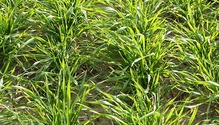
Across much of the Wheat Belt it is not uncommon to graze beef cattle on the vegetative growth through winter and then also harvest a grain crop from the same field. Oklahoma extension specialists estimate that 40 to 60 percent of their wheat acres are grazed during the winter.
In such a system, the critical question becomes one of when should cattle be pulled off wheat fields so that grain yield is not significantly reduced. The dual-purpose wheat is planted earlier than grain-only wheat and typically yields less anyway. Leaving stocker cattle on wheat too long further reduces yield and the extent of the reduction depends on several factors. These factors were discussed by Jeff Edwards, Oklahoma State small grains specialist, and Gerald Horn, OSU beef nutritionist, in a recent issue of the American Society of Agronomy's Crops & Soils magazine.
Research in Oklahoma has shown that first hollow stem is the stage to target for pulling cattle off wheat fields. Depending on the year and field conditions, grain yield can be reduced by as much as 1 to 5 percent per day if fields are grazed beyond this stage. Removing cattle at the first hollow stem stage leaves enough “green factory” for the wheat to recover and produce optimum grain yields.
The OSU specialists note that there is no single date when first hollow stem occurs every year. For one thing, wheat varieties differ in their development. In Oklahoma, varieties are evaluated and classified from very early to very late. The data is made available in the university’s Wheat Variety Comparison bulletin. Further, popular varieties are monitored each year, and the date of first hollow stem is reported on the OSU World of Wheat blog. Aside from variety, environmental conditions during winter and spring impact when the first hollow stem will develop.
Checking for first hollow stem
Diagnosing the first hollow stem stage requires going to a nongrazed area such as field corners or areas outside the fence line. The OSU researchers suggest that four or five plants be dug out of the ground because in early spring much of the hollow stem is below ground.
Split the largest tiller lengthwise with a sharp knife or box cutter. If there is 1.5 centimeters (5/8 inch) of hollow stem below the developing wheat head, this is considered the hollow stem stage. The gap length is about the same diameter as a U.S. dime.

